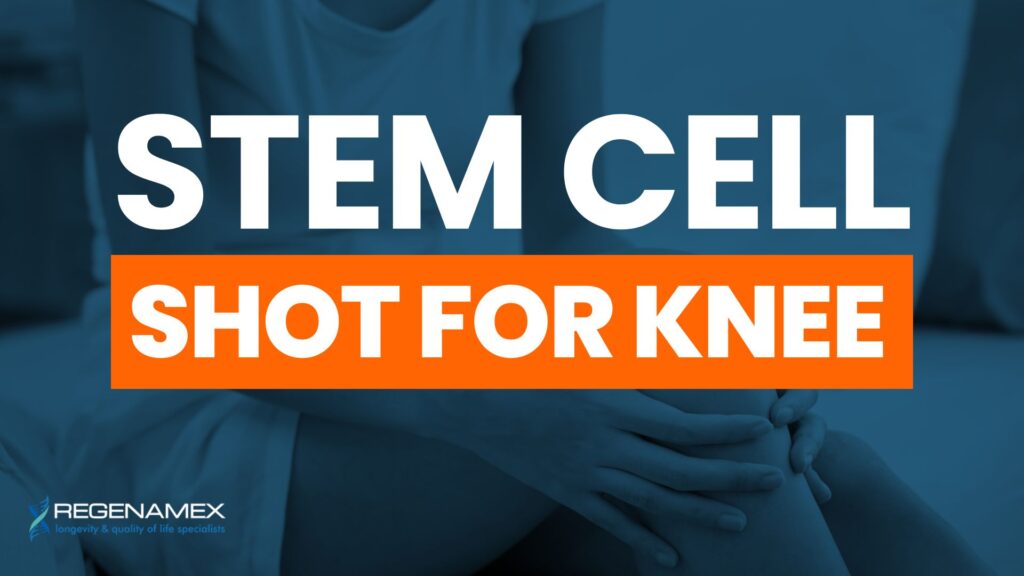
Stem Cell Shot for Knee
A stem cell shot for knee delivers an injection of mesenchymal stem cells (MSCs) directly into the knee joint to reduce pain, improve function, and potentially regenerate damaged cartilage and connective tissue. At clinics like Regenamex in Mexico, these treatments use ethically-sourced MSCs derived from Wharton’s jelly and placental tissue, processed under strict COFEPRIS regulation. Patients from around the world are turning to this regenerative knee therapy as an alternative to medications and surgery.
In this article we’ll dive deep into how a stem cell shot for knee works, explore the related procedures (such as regenerative knee injection, knee stem cell therapy), examine the research evidence, review cost and suitability, and help you decide if this option is right for you.
Understanding Knee Degeneration and Why Regenerative Treatment Helps

Decades of loading, micro-injury, and low-grade inflammation gradually change the biology of the knee joint. Cartilage loses water and proteoglycans, the subchondral bone hardens and develops microfractures, and the synovium can become inflamed—together fueling a cycle of pain, swelling, and stiffness. These changes also alter joint mechanics: muscles compensate, gait patterns shift, and the knee experiences higher shear forces that accelerate wear. Standard care aims to calm pain and improve function, but it rarely alters this degenerative spiral because it doesn’t rebuild a healthy cartilage matrix or restore the joint’s biochemical balance.
A stem cell shot for knee approaches the problem upstream. By introducing mesenchymal stem cells (MSCs) into the joint, you’re not just numbing pain—you’re changing the inflammatory signals, recruiting native repair cells, and nudging the tissue toward regeneration. MSCs can quiet overactive cytokines, improve the synovial environment, and support cartilage and meniscal repair at the microscopic level. That’s why earlier intervention generally performs better: when there’s still some viable cartilage scaffold left, regenerative signaling can take hold more reliably and help stabilize the joint before damage becomes structural and irreversible.
How Stem Cell Shot for Knee Works — Preparation & Delivery Methods
A precise plan comes first. Imaging (X-ray/MRI) maps cartilage thickness, osteophytes, alignment, and marrow changes, while the clinical exam pinpoints pain generators and mobility limits. At Regenamex, allogeneic MSCs sourced from Wharton’s jelly/placental tissue are prepared in GMP settings so the dose, sterility, and viability are tightly controlled. Your protocol (cell count, target sites, number of sessions) is then tailored to disease stage, alignment, and activity goals, and may include rehab and metabolic support to maximize outcomes.
For delivery, the team uses ultrasound or fluoroscopy to guide intra-articular injections to precise regions (e.g., supra-patellar pouch, medial/lateral compartments). Some cases benefit from adjuncts—micro-needling of cartilage, biologic scaffolds for focal defects, or pairing with PRP/exosomes to amplify signaling. Technique matters: correct needle trajectory, avoiding synovial “leak,” and dosing across compartments can improve exposure of damaged tissues to MSC secretions, which is where much of the therapeutic effect originates.
Evidence, Clinical Studies & Success Rates
Clinical literature shows a consistent trend: MSC injections can improve knee pain and function for many patients, particularly within the first 6–12 months, with some sustaining benefits beyond a year. Meta-analyses and systematic reviews report meaningful pain reduction on tools like VAS and WOMAC, while also noting that structural cartilage regeneration data remain mixed due to variable protocols and study designs. The signal is strongest in early-to-moderate disease, where there’s still a biological “platform” for repair.
Real-world outcomes mirror the science. Patients with Grade 2–3 osteoarthritis often report faster return to activities and less reliance on NSAIDs after a regenerative knee injection program, whereas advanced (Grade 4) cases are more variable and may still progress to surgery. Technique, cell quality, dose, and aftercare all matter. Well-selected candidates, high-quality cells, image-guided placement, and structured rehab typically push success rates higher and make improvements more durable.
Stem Cell Shot for Knee vs Traditional Treatments
Traditional care—NSAIDs, corticosteroids, hyaluronic acid—can be helpful for symptom control, but the effect is often short-lived because it doesn’t remodel tissue. Surgery is definitive for severe deformity or end-stage OA, yet it brings higher risks, hospitalization, and long rehabilitation. By contrast, a stem cell shot for knee is minimally invasive, clinic-based, and designed to modulate biology rather than simply mask pain or replace parts. For many, it’s the missing middle path between pills/injections and a prosthetic joint.
That said, the best strategy is individualized. Advanced bone-on-bone arthritis may still warrant arthroplasty, while earlier disease can benefit greatly from regenerative approaches that preserve native structures. Many patients also pair biologics with targeted physical therapy, weight optimization, and gait retraining to reinforce gains. The takeaway: regenerative therapy expands options and can delay or avoid surgery, especially when used before degeneration becomes irreversible.
Why Choose Regenamex for a Knee Stem Cell Shot
Regenamex pairs scientific rigor with practical accessibility. All MSCs are ethically sourced from Wharton’s jelly/placenta and processed in COFEPRIS-regulated, GMP-certified labs, giving you transparent documentation on sterility, identity, and viability. Protocols are customized—dose, targets, and adjuncts like PRP/exosomes—based on your imaging, symptoms, and performance goals. Image-guided delivery and structured follow-up are standard, not extras.
For international patients, value matters. Mexico’s lower overhead lets Regenamex offer world-class protocols at a fraction of U.S./Canada prices—without cutting corners. The Fly & Buy program streamlines travel, lodging, and scheduling, while aftercare support (rehab guidance, periodic check-ins) helps you maintain results. It’s a comprehensive, ethical, and cost-sensible path for patients who want regulated regenerative care.
Benefits & Risks of a Stem Cell Shot for Knee

Benefits: Many patients experience meaningful pain reduction, smoother motion, and improved function within months. Because the therapy is biologically active, improvements can continue as the joint microenvironment shifts from inflammatory to reparative. The procedure is outpatient and minimally invasive, with quick return to daily activities. In earlier disease, it can slow degeneration and may delay or avoid joint replacement while preserving native structures.
Risks/Limitations: Responses vary, especially in advanced OA. While safety is favorable in regulated settings, minor swelling or soreness can occur, and rare complications are possible with any injection. Evidence for large-scale cartilage regrowth is still developing, and protocols aren’t yet standardized across clinics. Coverage is typically out-of-pocket. Framing expectations correctly—promising tool, not guaranteed cure—plus diligent aftercare (rehab, weight control, joint mechanics) improves the odds of durable success.
What to Expect During Treatment at Regenamex
Pre-Treatment: You’ll complete imaging, labs, and a detailed evaluation. The team designs your plan—MSC dose, target areas, and whether to layer PRP/exosomes—then preps cells in a COFEPRIS-regulated GMP lab. You’ll also get guidance on pre-hab (mobility/strength), medication adjustments, and day-of logistics to keep things smooth.
Treatment & Aftercare: Under local anesthesia and real-time imaging, the MSCs are injected precisely into the knee compartments that need them. You’ll be observed briefly, then head home the same day. Most people resume light activity within 24–48 hours, with progressive gains over weeks. Follow-ups at 3, 6, and 12 months track pain, function, and, if needed, imaging. Aftercare can include targeted PT, gait training, weight management, and optional boosters to consolidate improvements.
Long-Term Outlook of Stem Cell Shot for Knee
When used at the right stage and supported by smart rehab, a knee stem cell shot can produce durable gains—often 12–24 months or more of better pain control and function, with some patients maintaining benefits longer. The joint tends to feel more “forgiving,” allowing return to walking programs, low-impact sports, and daily tasks with less reactivity. Early wins (less night pain, easier stairs) often lead to broader life improvements—more movement, better weight control, and healthier cartilage loading.
It won’t replace knee replacement for everyone, but it can meaningfully push that timeline back or avoid it for a subset of patients—especially those who intervene before bone-on-bone collapse. Regenamex’s emphasis on regulated cells, precise delivery, and committed aftercare increases the likelihood that biological change translates into real-world function you can feel every day.
FAQs: Stem Cell Shot for Knee
A stem cell shot for knee is a regenerative procedure that uses mesenchymal stem cells (MSCs) to repair damaged knee tissue, reduce inflammation, and support cartilage regeneration. These MSCs—often sourced from Wharton’s jelly or placental tissue—are injected directly into the joint space under image guidance. Once inside, they release growth factors and cytokines that calm chronic inflammation, stimulate resident repair cells, and help restore the cartilage matrix. This process not only relieves pain but also addresses the root cause of degeneration, unlike conventional injections that merely mask symptoms. Over time, patients may notice better flexibility, strength, and long-term joint stability as the microenvironment of the knee becomes healthier and more balanced.
Clinical studies show that knee stem cell therapy can lead to significant improvements in both pain and function, particularly for early-to-moderate osteoarthritis. Many patients report up to 70–90% improvement in symptoms within six to twelve months after treatment. The therapy’s success depends on factors like age, cartilage condition, and adherence to post-treatment rehab. By modulating inflammation and promoting tissue repair at a cellular level, regenerative knee injection can restore smoother movement and delay the need for surgical intervention. While results vary, Regenamex patients consistently report sustained pain relief and better mobility—often maintaining improvements for two years or more.
Cortisone and hyaluronic acid injections temporarily reduce inflammation or improve joint lubrication, but they don’t rebuild cartilage or modify disease progression. In contrast, a regenerative knee injection using mesenchymal stem cells actively repairs tissue damage. MSCs target the underlying cellular imbalance that drives osteoarthritis, releasing regenerative molecules that stimulate cartilage-producing cells and improve joint fluid quality. Over time, this biological healing process restores smoother motion and better shock absorption, offering long-lasting relief instead of short-term symptom control. For patients seeking a solution that addresses both pain and degeneration, a stem cell shot for knee represents a more advanced, sustainable option.
The best candidates for stem cell therapy for knees are patients with early to moderate cartilage loss, chronic pain, or joint stiffness who want to avoid or delay knee replacement surgery. Individuals with osteoarthritis, meniscus tears, or degenerative joint conditions that still have some cartilage remaining tend to respond particularly well. Younger patients or those with healthy lifestyles often experience faster and more durable results, though Regenamex also treats older adults successfully. Advanced “bone-on-bone” cases can still benefit from pain reduction, but complete regeneration may be limited. A detailed MRI and consultation at Regenamex help determine suitability and customize each patient’s protocol for optimal outcomes.
Every procedure at Regenamex follows a carefully structured process. After your consultation and imaging, MSCs derived from Wharton’s jelly or placental tissue are processed in COFEPRIS-regulated, GMP-certified labs for sterility and potency. On treatment day, you’ll receive a local anesthetic to minimize discomfort. Using ultrasound or fluoroscopic guidance, the physician injects the MSC preparation precisely into the joint space or damaged cartilage zones. The process takes about 60–90 minutes, is minimally invasive, and requires no general anesthesia. Most patients walk out of the clinic the same day, with mild soreness that resolves in 24–48 hours. Over the following weeks, biological repair begins as inflammation subsides and tissue recovery accelerates.
Results from a stem cell shot for knee pain build gradually as the regenerative process unfolds. Most patients notice a reduction in inflammation and discomfort within 4–6 weeks. Over the next three to six months, cartilage metabolism and joint lubrication continue improving, leading to greater flexibility, strength, and reduced stiffness. Optimal results usually appear between six and twelve months post-procedure, as the new tissue remodeling and vascularization reach maturity. The effects are long-lasting and, with proper rehabilitation and lifestyle maintenance, can persist for several years before any booster treatments are needed.

